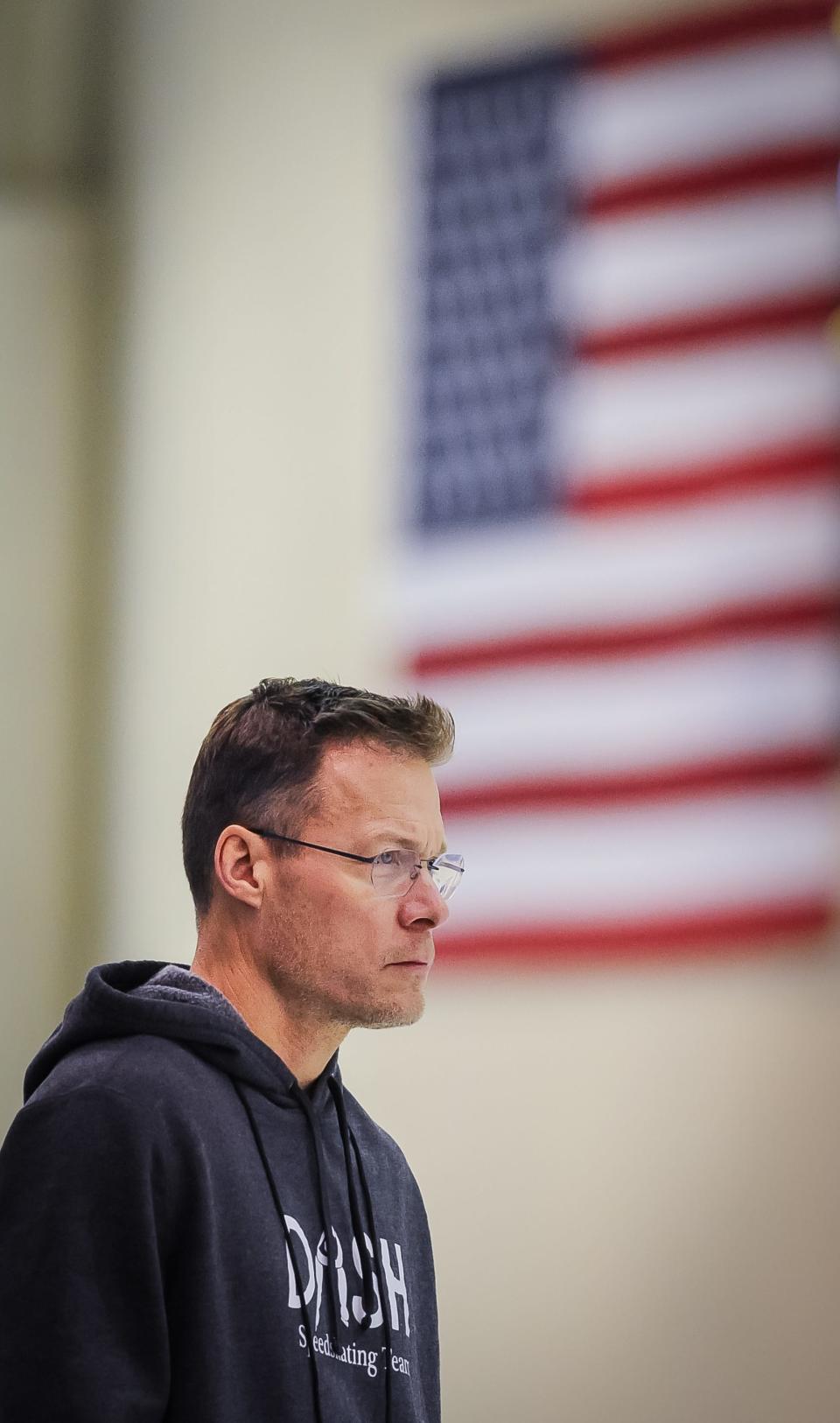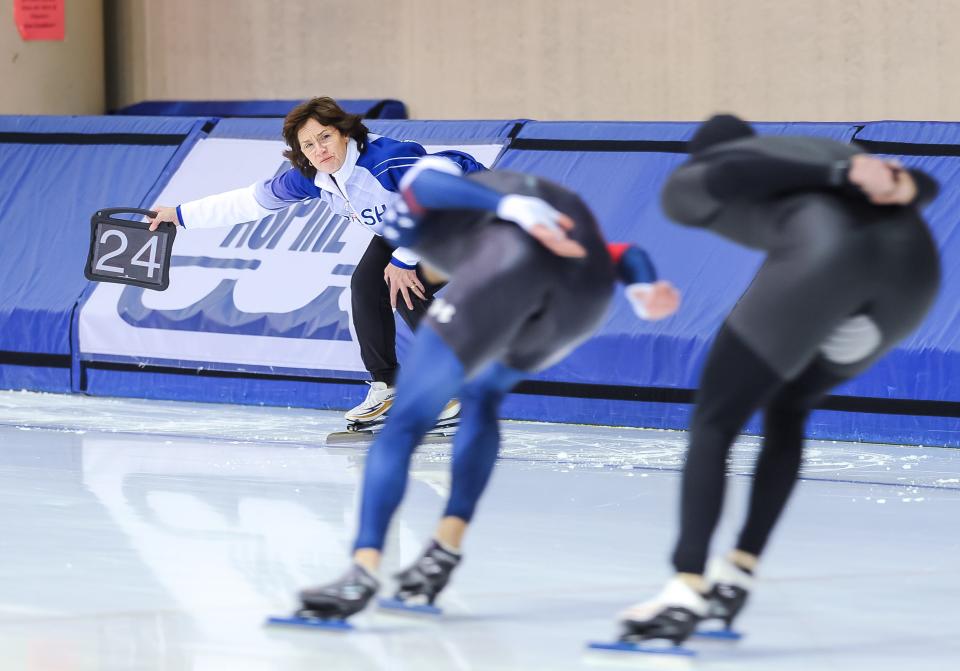Speedskating slipped, but Bonnie Blair and her husband aim to make Milwaukee a mecca again

Dave Cruikshank does not mince words.
The national championships in the sport that took him to four Olympics and put his wife on a cereal box are coming up quickly.
They’re practically in his backyard, at a venue where some of the sport’s greats have trained and one today’s hottest prospect calls home.
But hardly anyone knows, and Cruikshank wants to change that.
“The future of (U.S.) speedskating is dependent on this location,” Cruikshank says. “Period.”
He is sitting in the cube of an office tucked into the gym overlooking the Pettit National Ice Center’s 400-meter speedskating oval. Seated alongside is the most decorated woman in U.S. Winter Olympics history with five gold medals and one bronze, his wife and a partner in DASH Skating, Bonnie Blair.
“We’ve always been a sport where we get looked at every four years,” Blair says. “We’d like to be a sport people look at more frequently than that.
“Here in Wisconsin we’ve got such a rich history of athletes who’ve come through here.…”
Athletes such as Dan Jansen and Chris Witty, who grew up in West Allis, as Eric and Beth Heiden of Madison – who trained on the Wisconsin Olympic Ice Rink that preceded the Pettit on the same site at State Fair Park – and Blair, whose four Olympics straddled the construction of the indoor facility.
“… And even some of those athletes that live in Salt Lake," she continues, “they’ve all skated here, raced here, maybe trained here for a couple of weeks here and there.”
U.S. long-track speedskating championships are this weekend at the Pettit National Ice Center
This weekend top American skaters will compete at the Pettit in the U.S. long-track championships with action beginning at 9 a.m. Friday, Saturday and Sunday.
The meet will set the U.S. team for the first half of the World Cup season and AmCup, as well as the squad that will represent the United States at the Youth Olympic Winter Games in January in Gangwon, South Korea.
Skaters to watch include Erin Jackson, who in 2022 became the first Black woman to win Winter Olympic gold in an individual sport, and Jordan Stolz, the 19-year-old Kewaskum native who rewrote the Pettit record book and became the youngest male athlete to win an individual World Cup race.
In addition to World Cup and Olympic veterans such as Jackson and Stolz, Brittany Bowe and Mia Manganello-Kilburg, and Emery Lehman and Austin Kleba, the competition will include a handful of DASH-trained skaters such as Blair Cruikshank, the 23-year-old daughter of Blair and Cruickshank, and Auggie Herman, who moved from Minnesota to train at the Pettit.
Admission is free. Attendance was light when the U.S. championships were held at the Pettit in January. (The event has moved from winter to fall this year due to a rule change by the International Skating Union, which governs the sport. There’s another World Cup qualifier set for January in Salt Lake City, where the U.S. national team trains.)
The era of Bonnie Blair and Dan Jansen was a golden age for speedskating, especially in Wisconsin
Wisconsin has had a place in speedskating history for almost a century with trials for the 1928 Olympics held in Oconomowoc, according to UW-Milwaukee’s Encyclopedia of Milwaukee. The West Allis Speed Skating Club built a reputation through the mid-century, and in 1966 the Wisconsin Olympic Ice Rink opened.
Among those who trained at the outdoor rink were the Heidens, with brother and sister both qualifying for the Games twice. Neither medaled in 1976, but four years later at Lake Placid, Eric swept all five events, from 500 meters to 10,000, in record time and Beth earned a bronze medal in the 3,000.
“Especially around here, Eric kind of started that,” Blair said of the sport grabbing attention in ways it hadn’t. “Eric really majorly put our sport on the map.”
Blair, born in New York, raised in Illinois and trained in Milwaukee, qualified for the ’84 Games in Sarajevo. Then she earned a gold and a bronze in ’88 in Calgary, won both the 500 and 1,000 in ’92 in Albertville and repeated both in ’94 in Lillehammer.
While Blair’s story was one of prolonged success, Jansen’s was one of heartbreak and perseverance that transcended sports. A week after winning the ’88 world championship at the Wisconsin Olympic Ice Rink, Jansen fell in the 500 in Calgary on the day his sister died of leukemia during his second Games. In all, he would compete in seven races over four Olympics without medaling before taking gold in his final opportunity, the 1,000 meters in ’94.
US Speedskating’s move to Salt Lake City changed things
First the Olympic rink and then the Pettit Center, once it opened in December 1992, served as primary training grounds for U.S. Olympic speedskaters. But with the Winter Games headed for Salt Lake City in 2002, US Speedskating moved its base to the new rink there in 2001.
Suddenly Milwaukee played a much smaller role in the sport.
For the health of speedskating, that doesn’t make a lot of sense to Blair and Cruikshank, who – selfishly or not – see advantages in the larger size and favorable location of their adopted hometown.
“We’re a convenient facility, right?” Blair said. “We’re right on the interstate. You’re not too far from Madison, where you had the likes of Casey FitzRandolph and Eric and Beth Heiden, who would travel back and forth from here on a daily basis.
“Dave grew up in the Chicago suburbs and in his high school years he was going back and forth every day. We have that ability to draw off of a lot of surrounding areas, but we need to start trying to gain that momentum of letting people know we’re still here, we exist, we want athletes to be involved in it.”

A shift in sports culture changed speedskating too
Parallel to the westward move, skating at the club level had begun to falter as it became increasingly difficult for parents to volunteer their time and paid coaches made a relatively inexpensive sport more costly, Cruikshank said.
“Back in our day, her mom, my mom, ladies in the community, fathers in the community, whether they were flooding ice rinks in Northbrook, where I was from … they got the firehouse out, the dad literally did the ice every night,” Cruikshank said. “The moms were in the park district. They were in the PTA. They were in the bridge groups … ‘hey, your kid should try speedskating’. So there was a network and a net that was cast really wide to catch families and talent.”
A primary goal of DASH is to keep speedskating accessible and again capture some of that talent.
Herman, 20, is an example of the sort of athlete who could have gotten away. He was trying to play hockey, but a late arrival at age 10, he couldn’t handle the stick well.
“Then one time at open skate I saw a speedskater,” Herman said. “I was really into track and field, I was really into ice skating and I didn’t know that that existed, and when I saw that, it was like, that’s perfect.”
Herman, who won a gold medal at the Junior World Championships, is already thinking about his post-competition days when he plans to help build the sport and train the next generation.
“I think it’s way too fantastic of a sport, way too beautiful of a sport that offers way too many opportunities, especially for young kids, for it to be so small,” Herman said.

Jordan Stolz is the new face of speedskating
Speedskating has begun to gain some traction again in southeast Wisconsin recently thanks to Stolz, who went from a backyard pond in Kewaskum to the world stage in warp speed, becoming what Cruikshank calls “the best skater on the planet.”
During the Olympic trials almost two years ago, Stolz obliterated two Pettit Center records set 15 years earlier by four-time Olympic medalist Shani Davis, and his stock has continued to rise.
Ideally, Blair said, Stolz can be an inspiration to younger skaters without taking on pressure to do so.
“I remember that when I was growing up. I was like, oh, my gosh, I was on the same ice with Eric Heiden,” Blair said. “That’s a cool thing.
“The average person doesn’t know he’s out here and training. Those (young athletes) that we bring in, we hope they get that excitement going, we hope that they start following him and he can not necessarily put it on his shoulders as a weight but maybe put it underneath his feet and raise him up even higher.”
Said Cruikshank: “Jordan can be the guy. But if we’re relying on one guy to save the sport, we’re in trouble.”
Rebuilding the sport will take time
That’s where DASH comes in. The goal for Cruikshank, Blair, their partners and their skaters is to generate interest, cultivate talent, showcase the best athletes and to energize the community to help rebuild their sport from Milwaukee to the Olympics.
“It’s our job to spread the word about what goes on at the Pettit … and let people know that the building is a very special landmark in the state of Wisconsin and the Midwest and certainly in the city of Milwaukee,” Cruikshank said.
“If I poll the next hundred people who walk by, they’re not going to know that our national championships are here. We need to do a job in future times of making sure people know and getting people involved in what skating used to be in West Allis in the ’70s, ’80s, ’90s. When Bonnie and Dan were household names in the United States.”
This article originally appeared on Milwaukee Journal Sentinel: Bonnie Blair, Dave Cruikshank work to draw attention to speedskating

